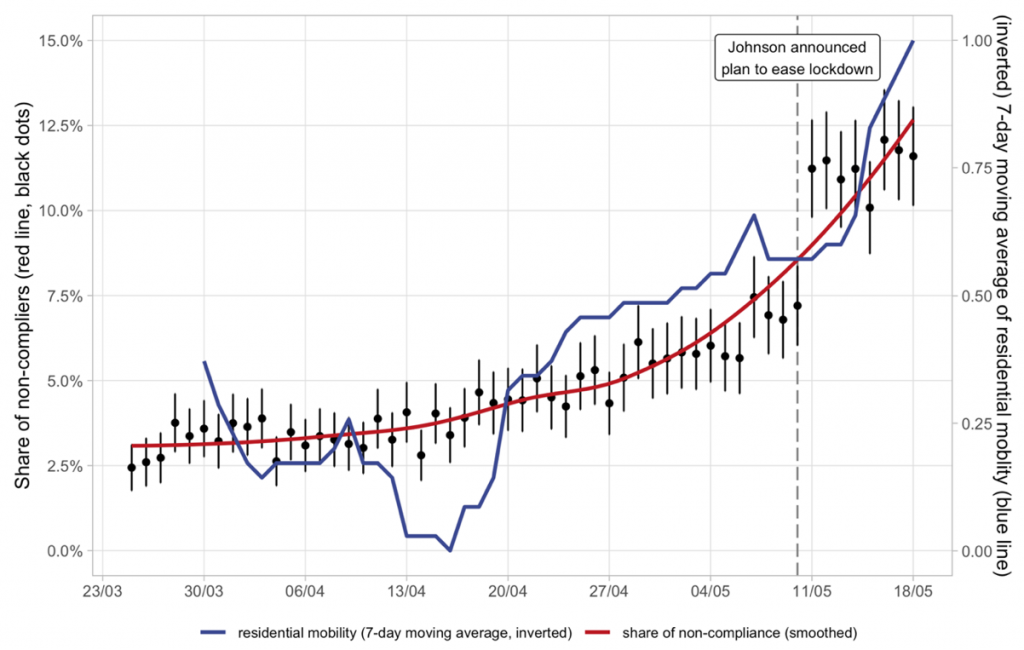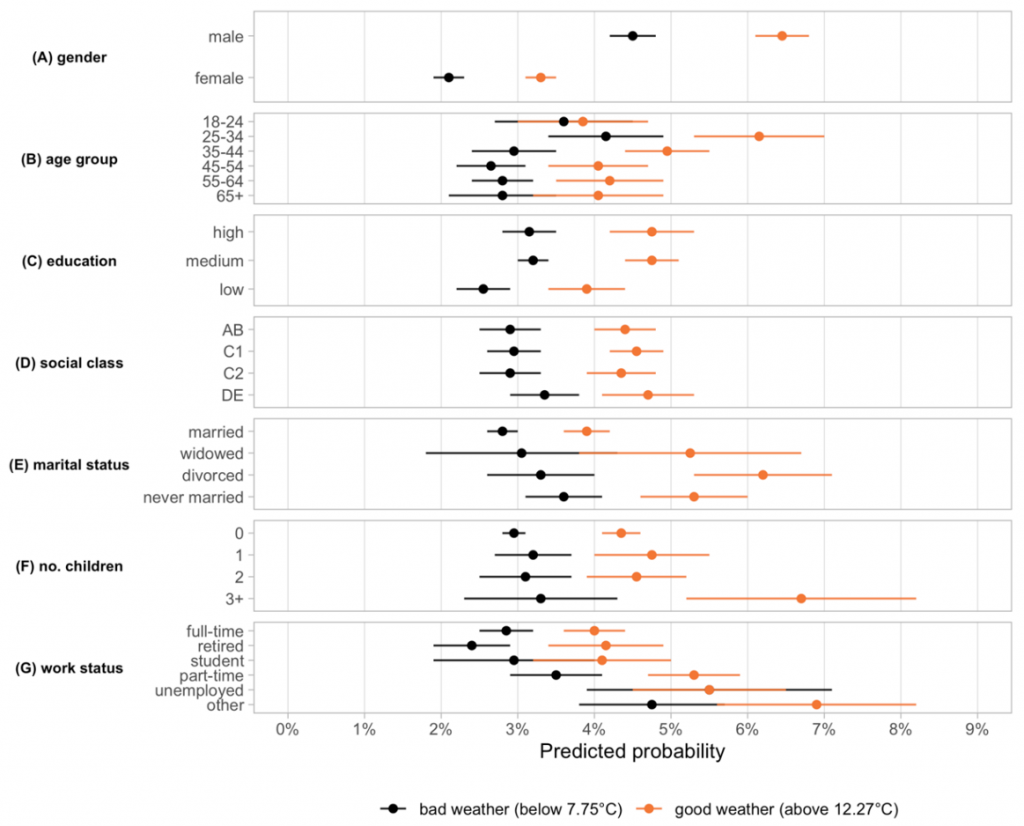Despite the success of COVID-19 vaccination campaigns across the world, the emergence of new strains of the virus may delay the relaxation of certain lockdown measures. Michael Ganslmeier, Jonathan Van Parys and Tim Vlandas argue that understanding individual-level compliance with social distancing rules will be essential in the coming months – especially as compliance with public health guidelines is substantially lower among certain groups during warmer periods of the year.
Who complies with social distancing measures? This question is crucial to effective policy responses to the ongoing pandemic. A large body of literature has shown the effectiveness of social distancing rules for virus containment. Yet, their impact on new cases ultimately depends on the willingness of the population to comply with these measures, especially since full enforcement is often neither feasible nor even desirable.
In a new study, we attempt to identify the individual-level determinants of compliance by analysing a very large YouGov survey dataset with over 105,000 individuals in the United Kingdom during the first national lockdown in the early period of the pandemic.
Non-compliance with lockdown rules has increased over time and varies widely across different groups of society
The first UK national lockdown was announced in March 2020. Previous research has shown that the announcement was associated with more positive popular perceptions of government handling of health, while the opposite was true for perceptions of its handling of the economy. As shown in Figure 1, compliance with lockdown policies initially tended to be high (~95%) in the overall population. However, the average share of non-compliers in the early period of the pandemic then rose steadily after the introduction of the lockdown. One particularly notable increase in non-compliance is observable after the UK government announced its plans for re-opening on 10 May 2020. This national level of compliance also hides substantial regional variation with some parts of the UK facing a much larger share of non-compliers.
Figure 1: The share of non-compliers steadily increased from the end of March until mid-May 2020
Note: On 10 May 2020, UK Prime Minister Boris Johnson announced the government’s plan to exit lockdown, which led to a significant jump in the share of non-compliers. The plot shows the average non-compliance shares for each day (black dots) with the corresponding 95% confidence intervals (vertical lines, sample weights are applied). The blue line is a smoothing function based on non-compliance averages from previous days. The red line represents the (inverted and rescaled to a 0-1 range) 7-day-moving-average of the residential mobility indicator provided by Google. N = 105,512.
Moreover, our empirical analysis shows that differences across individuals can be sizeable. First, female respondents are much more likely to comply with rules than male respondents. Indeed, the probability of non-compliance is 6% for men but only 3% for women.
Second, age has been shown to matter a great deal for the health risks that different individuals face when confronting the risk of COVID-19 infections. As a result, younger individuals between the ages of 25 and 34 have a significantly higher predicted probability of not following the regulations when compared to people over 45.
Third, different individuals may face varying economic pressures that influence their compliance with lockdown regulations. Indeed, respondents who are unemployed or on a part-time contract have substantially higher predicted probability of non-compliance than workers in full-time employment.
Surprisingly, and in contrast to much of the conventional wisdom in public debates, social class has no statistically significant effect on individuals’ likelihood of complying. Although education has a significant effect, we find that more highly educated individuals are in fact less likely to comply with government rules.
Finally, an individual’s family situation also appears to play an important role: whereas marriage increases the probability of compliance, having more than two children lowers it.
Warmer temperatures increase non-compliance with social distancing rules
Even though infection rates show obvious epidemiological seasonality – with fewer cases in warmer periods of the year – the effect of weather is mostly overlooked in compliance studies, despite its potential relevance for social behaviour. We address this gap by merging our YouGov survey data with highly granular meteorological data. This makes it possible to explore whether temperature, sunshine, and/or rain have potential compounding effects on individual behavioural compliance with rules.
We find large heterogenous effects of weather on compliance, depending on certain individual-level characteristics. The heterogeneous effects of weather are substantial for temperature, but moderate for solar radiation, and largely minor and/or statistically insignificant for rainfall. Overall, the largest amplification of non-compliance under warm temperature conditions can be observed for four individual level characteristics: being male; being divorced; being part-time employed; and having more than two children.
Figure 2: Warmer temperatures have a substantial effect on non-compliance among individuals with certain demographic and socio-economic characteristics
Note: The panels show the predicted probability of non-compliance when a given individual level characteristic is equal to 1 while all other covariates are held constant at their mean values. The black (orange) dots are estimates based on observations under bad (good) weather conditions, which are defined along the top and bottom quartiles (7.75°C and 12.27°C, respectively) of temperature. The estimates are based on a logistic regression with date and region fixed effects included and robust standard errors clustered at the region level. The horizontal lines show the 95% confidence intervals. N = 105,512.
To illustrate, while the probability of non-compliance for female respondents rises from 2.1% during cold temperatures to 3.2% during warm temperatures, for male respondents the probability increases from 4.5% to about 6.5% between cold and warm periods. Interestingly, divorced individuals as well as parents of more than two children show an even greater sensitivity to temperature changes, with non-compliance probabilities in warmer environments being more than twice as large compared to colder periods.
Understanding compliance will remain essential as long as herd immunity is not achieved
In the absence of effective containment measures, the negative consequences of the pandemic for health and the economy are substantial for many countries around the world. While achieving herd immunity through vaccination is ultimately the best way out of this crisis, even countries with advanced vaccination campaigns such as the UK will require social distancing measures in the medium term to prevent the uncontrolled spread of new variants such as the current Delta variant.
Thus, understanding individual-level compliance with lockdown rules will be essential for future containment policies. One challenge for policymaking is that the groups that are not yet vaccinated (or are anti-vaccination) are often the ones that are less likely to comply with public health measures aimed at preventing contagion. As a result, more targeted policy interventions may be required, for instance in the form of economic support for vulnerable groups and/or prevention of risky behaviour among less compliant groups.
______________________
Note: The above was first published on LSE EUROPP. It draws on the authors’ study available here.
Michael Ganslmeier is a DPhil student in Social Policy at the University of Oxford.
Jonathan Van Parys is Chief Digital Officer at YouGov.
Tim Vlandas is an Associate Professor of Comparative Social Policy at the University of Oxford.
Photo by Serj Sakharovskiy on Unsplash.









